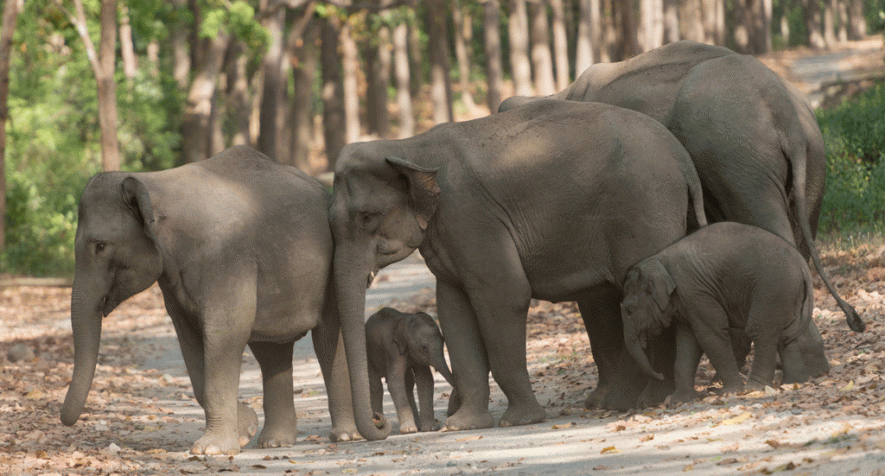Odisha Wildlife Under Serious Threat as State ‘Celebrates’ Wildlife Week

Image Used for Representational Purpose Only
Bhubaneswar: For Odisha’s fast dwindling wildlife involving tigers, elephants, leopards, turtles, bears, parakeet, pangolin and many other species, life continues to be stressful, fraught with risks and a daily struggle for food in a fast depleting habitat, even as the government ‘celebrates’ Wildlife Week this October.
While the elephant population is the worst hit, with over 700 deaths in the past nine years, the number of tigers remains the same or static, along with regular cases of leopard poaching being reported.
Besides the frequent poaching of pangolins and continuous killing of the Olive Ridley turtles by trawlers, bears and parakeets are also facing a serious threat to their existence.
In the absence of any concrete action plan to protect these precious lives amid rapid tree felling and depleting forest cover, Odisha will soon become a state without wildlife, says Biswajit Mohanty of Wildlife Society of Odisha.
The apathy of the state can be gauged from the fact that the Odisha State Board for Wildlife, headed by Chief Minister Naveen Patnaik, has hardly met in the past two decades. Whenever it does meet, it is to clear development projects in eco-sensitive zones.
Barring the wildlife week celebrations each year, when the state government pats itself on its back, the Chief Minister and Minister for Forest & Environment never come to the forefront to review wildlife management.
It may be noted that while wildlife-rich states, such as Karnataka, Tamil Nadu, Kerala, Maharashtra, Madhya Pradesh, Chhattisgarh, Uttarakhand etc., are implementing viable wildlife management plans, the Odisha government is lagging way behind.
It is reported that a consultant was paid more than Rs 3 crore but the wildlife management plan is yet to be delivered even after four years!
ELEPHANTS – WORST SUFFERERS
In the past nine years and six months (Since April 2010), 727 elephants have died, of which 257 (more than 35%,) have died due to unnatural causes – 113 due to electrocution, 77 to poaching, 26 to poisoning, 26 were hit by trains, five hit on roads, and 10 after falling into manmade structures, such as open wells and irrigation projects. The reasons for death could not be ascertained in 147 cases as the carcasses were found in a decomposed state and some were just skeletal remains.
Last year saw the highest elephant mortality till date – 91 of them, of which 36 were due to unnatural causes and in 27 cases the reason could not be known. The year also saw the highest number of electrocutions till date – 24 of them, of which 12 were due to sagging power lines and 12 by hooking live wires for poaching.
The electrocution of seven elephants near Kamalanga, Dhenkanal, on October 27, 2018 is recorded as one of the biggest ever tragedies in the annals of India’s wildlife history. The recent months saw seven elephants killed by trains, four of which were part of one incident near Teldihi in Jharsuguda on April 16, 2018. The period also saw the highest number of killings of humans by elephants at 92, signaling the worsening of human-animal conflict.
During 2019-20, with six months still to go, Odisha has already lost 33 elephants and human killings by the animal is at an alarming high of 59, recording an all-time high mortality of both elephants and humans. The death of three elephants on the National Highway at Balijodi, Keonjhar on August 22, 2019 is among the worst recorded such incident on Indian roads.
Yet, the Odisha government has done woefully little or nothing to prevent the unnatural death of elephants. Hundreds of locations still have sagging power lines. Prevention of live wire poaching is not eing undertaken due to lack of regular night patrols. Till date, no underpass has been made across vulnerable railway lines and roads for safe passage of elephants and other wildlife. The 30-metre underpass approved by the Chief Wildlife Warden for the Manguli- Sambalpur NH, shall never be used.
Overall, human tolerance for elephants is fast waning as angry farmers are running pillar to post seeking compensation for crop loss and are also retaliating.
BIG CATS VANISHING
While the tiger population has gone up in most Indian states, it has come down or remained static in Odisha. In 2004, the state had claimed the presence of 192 tigers, which came down to 28 in 2014. Even after spending crores of rupees on tiger conservation during the past four years, their numbers continued to stagnate at 28 in the 2018 census. Similipal, which houses most of the tigers, has witnessed rampant poaching of herbivores, the tiger’s food, due to the failure of the authorities to control poaching.
Satkosia went for a tiger tourism venture in June 2018 which went horribly wrong within two months, as one of the two tigers relocated from Madhya Pradesh was poached and the other had to be caught and brought back into an enclosure after she attacked humans. Ironically, the government opted for the Rs 26 crore relocation project but five years ago opted to keep a straying Sakosia male tiger at Nandan Kanan Zoo in 2013, instead of releasing him to boost the Tiger population there.
The Sunabeda sanctuary, which had got in-principle approval about a decade ago from the Ministry of Environment and Forest, to turn it into a tiger reserve, has not been notified yet by the Odisha government, despite constant reminders from the National Tiger Conservation Authority.
POACHING OF LEOPARDS
Leopards are being regularly poached for their skin and body parts. This is evident from the fact that 11 leopard skins have been seized in Odisha in the past one and a half years and 26 men have been arrested, most of them in operations carried out by the Police Crime Branch.
The biggest seizure was in Kuchinda, Sambalpur, on March 15, 2019 when four leopard skins were seized by the Crime Branch and seven poachers/traders were arrested. The Forest Department was clueless about seven of the 11 skins seized and has failed to identify the source and where they were poached.
TURTLES IN TROUBLE
While Olive Ridley turtles, Odisha’s sports mascot, continue to be massacred in thousands off the Odisha coast by illegal trawlers, the Rushikulya river mouth nesting site did not witness mass nesting this year and yet again the Ridleys avoided the Devi river mouth nesting site.
The freshwater turtles of Odisha are having a bad time, too, as they are being poached in large numbers for smuggling to other states and abroad. In eight recorded seizures in the past one and a half years, mostly by the Railway authorities and police, nearly 2,900 freshwater turtles were seized.
One of the biggest freshwater turtle seizures in India was on May 25, 2018 when the Bengal police seized a truck from Bhubaneswar at Dhulagarh toll plaza which was transporting 2,500 turtles to North 24 Parganas.
PANGOLINS ON THE BRINK
Pangolin, the most trafficked wild animal in the world, was rampantly poached in the past 15 months. This is evident from the several seizures of pangolin scales and live pangolins. On June 18, 2018 when Shamsuddin Khan was caught with 5 kg of pangolin scales near Daspalla, Nayagarh, it was not known to the forest department that he was one of the most wanted wildlife smugglers in the state until the Crime Branch took over the case.
Khan’s arrest led to five more arrests, including two men from the North East, and exposed a network across several states spreading to South East Asia. The high demand for live pangolins was evident in last one year when eight of these were seized and reports of several more that got smuggled came to light.
Odisha’s rare horseshoe crabs witness mass deaths each year during their breeding season due to lack of protection to these grounds on sea shores.
The sloth bears of Odisha are also under constant threat from humans as attacks by bears have gone up due to competition for the same food source. Snakes, too, are being illegally rescued and displayed in the absence of licensed snake rescuers. Thousands of parakeet chicks are being smuggled to meet pet trade demand outside the state.
Though the state forest department has introduced a toll-free number at the Chief Wildlife Warden’s office for receiving information about wildlife poaching and smuggling, the Wildlife Crime Cell is inactive and ineffective as it does not have expertise and the required intelligence network to carry out seizures and arrests.
In addition, poachers and traders are easily getting bail and most of them are set free as the department does not have dedicated legal experts to ensure proper chargesheets and conviction.
In this backdrop, it is indeed ironical that the state is observing the Wildlife Week, even as animals and humans continue to die mainly due to state neglect and worsening human-animal conflict.
The writer is an independent journalist.
Get the latest reports & analysis with people's perspective on Protests, movements & deep analytical videos, discussions of the current affairs in your Telegram app. Subscribe to NewsClick's Telegram channel & get Real-Time updates on stories, as they get published on our website.

















